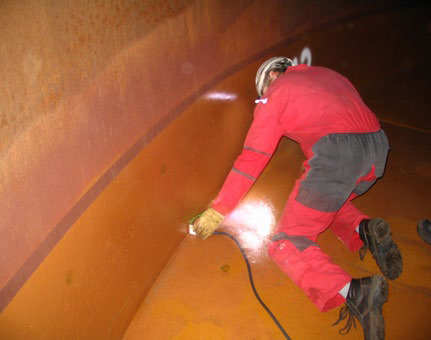A Detailed Review of Storage Tank Welding Evaluation Standards and Methodologies for Improved Weld Quality and Efficiency
The value of welding assessment requirements in the production of containers can not be overstated, as they offer as the foundation for making sure weld stability and functional integrity. Numerous examination strategies, including visual assessments and progressed non-destructive screening techniques, are crucial in identifying possible imperfections that can compromise performance.
Significance of Welding Evaluation Requirements

Welding evaluation criteria include a range of criteria, consisting of product specs, welding treatments, and certifications of personnel entailed in the welding process. By enforcing these criteria, companies can systematically identify and remedy possible flaws, consequently minimizing the possibility of expensive repair services or devastating failings. Extensive examination methods promote a society of responsibility and precision, motivating welders to preserve high degrees of craftsmanship.

Common Welding Examination Strategies


Ultrasonic Testing (UT) is an additional prevalent strategy, utilizing high-frequency audio waves to discover inner problems that may not be noticeable on the surface. This approach is especially efficient for identifying voids or additions within the weld metal. Magnetic Fragment Checking (MT) is additionally widely utilized, specifically for ferromagnetic products, as it discloses surface area and near-surface defects with the application of magnetic areas and ferrous bits.
Additionally, Fluid Penetrant Testing (PT) finds surface-breaking issues by applying a penetrant to the weld and afterwards using a developer to attract out the penetrant. Each of these techniques adds to a detailed inspection strategy, guaranteeing that welds fulfill the rigid quality requirements required in container building.
Regulatory Standards and Conformity
Regulative standards and compliance are essential elements in making certain the safety and integrity of bonded structures in container construction - Tank Welding Inspection. These requirements serve to develop minimum requirements for material residential or commercial properties, welding treatments, and inspection methods, therefore lowering the threat of architectural failures and enhancing general efficiency
Trick companies, such as the American Society of Mechanical Designers (ASME) and the American Welding Culture (AWS), provide standards that are widely embraced in the market. Compliance with these requirements not just guarantees adherence to finest techniques yet also meets legal and legal commitments, safeguarding the passions of stakeholders.
Governing bodies frequently mandate adherence to certain codes, such as ASME Code Area IX for welding certifications and API 650 for welded storage tanks. These codes lay out needs for welding techniques, qualifications of workers, and testing have a peek at this site methods to validate weld stability.
Regular audits and inspections are crucial to keeping conformity, as they aid identify deviations from established standards. Non-compliance can lead to considerable charges, job hold-ups, and security dangers. Therefore, a robust understanding of governing requirements and a dedication to compliance are extremely important in accomplishing top notch and long lasting bonded container structures.
Non-Destructive Evaluating Methods
Just how can the honesty of welded frameworks be guaranteed without triggering damage? Non-destructive testing (NDT) methods offer a durable remedy, making it possible for examiners to assess weld quality without jeopardizing the material - Tank Welding Inspection. Among one of the most common NDT strategies are ultrasonic screening (UT), radiographic testing (RT), magnetic particle testing (MT), and dye penetrant screening (PT)
Ultrasonic screening employs high-frequency acoustic waves to find interior flaws and identify product homes. It provides specific dimensions and is particularly reliable for thick materials. Radiographic screening involves passing X-rays or gamma rays via the weld, creating photos that expose structural flaws such as splits or spaces. This method is vital for evaluating the integrity of complicated welds.
Magnetic particle screening is suited for ferromagnetic products, where magnetic fields expose surface area and near-surface gaps. Color penetrant testing utilizes a fluid color to highlight surface-breaking flaws, making it an efficient method for non-porous materials.
Each of these NDT approaches has distinct advantages, allowing for detailed analyses tailored to certain materials and welding procedures. By implementing these techniques, sectors can make certain the integrity and safety and security of welded structures, inevitably boosting overall efficiency.
Enhancing Weld Top Quality Via Inspection
Effective evaluation plays a vital function in enhancing weld top quality, functioning as a vital checkpoint in the construction process. By determining possible issues early, inspections reduce the threat of endangered architectural integrity and ensure compliance with industry criteria. Using a combination of visual assessments, non-destructive screening (NDT) approaches, and mechanical evaluations, inspectors can spot concerns such as porosity, cracks, and incomplete fusion.
Carrying out a durable inspection method not just boosts the total top quality of welds but additionally fosters a society of liability among welders and makers. Regular training and accreditation of inspection workers make certain that they are geared up with the essential visit this website skills to acknowledge and resolve possible problems successfully. This aggressive method reduces rework and linked prices, ultimately adding to predict performance.
Moreover, extensive documentation of examination searchings for offers beneficial insights into repeating problems, helping with continual renovation in welding practices. By leveraging advanced innovations, such as automated ultrasonic testing or electronic radiography, weld high quality can be boosted with more specific assessments. To conclude, a rigorous assessment process is crucial in achieving top quality address welds, ensuring safety, reliability, and longevity in container construction.
Conclusion
In final thought, the application of strenuous tank welding examination requirements and methodologies is crucial for making sure weld integrity and performance. By utilizing a combination of visual inspections, non-destructive testing methods, and adherence to regulatory criteria, organizations can successfully determine and alleviate prospective defects.
Comments on “Advanced Techniques in Modern Tank Welding Inspection”